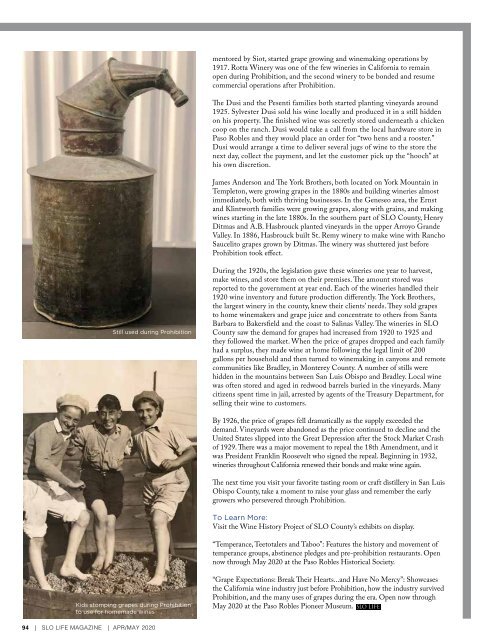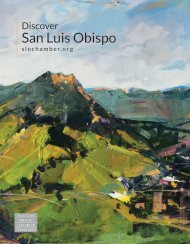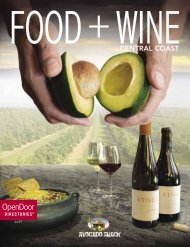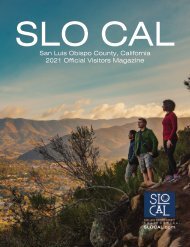SLO LIFE AprMay 2020 Low Res
Create successful ePaper yourself
Turn your PDF publications into a flip-book with our unique Google optimized e-Paper software.
mentored by Siot, started grape growing and winemaking operations by<br />
1917. Rotta Winery was one of the few wineries in California to remain<br />
open during Prohibition, and the second winery to be bonded and resume<br />
commercial operations after Prohibition.<br />
The Dusi and the Pesenti families both started planting vineyards around<br />
1925. Sylvester Dusi sold his wine locally and produced it in a still hidden<br />
on his property. The finished wine was secretly stored underneath a chicken<br />
coop on the ranch. Dusi would take a call from the local hardware store in<br />
Paso Robles and they would place an order for “two hens and a rooster.”<br />
Dusi would arrange a time to deliver several jugs of wine to the store the<br />
next day, collect the payment, and let the customer pick up the “hooch” at<br />
his own discretion.<br />
James Anderson and The York Brothers, both located on York Mountain in<br />
Templeton, were growing grapes in the 1880s and building wineries almost<br />
immediately, both with thriving businesses. In the Geneseo area, the Ernst<br />
and Klintworth families were growing grapes, along with grains, and making<br />
wines starting in the late 1880s. In the southern part of <strong>SLO</strong> County, Henry<br />
Ditmas and A.B. Hasbrouck planted vineyards in the upper Arroyo Grande<br />
Valley. In 1886, Hasbrouck built St. Remy winery to make wine with Rancho<br />
Saucelito grapes grown by Ditmas. The winery was shuttered just before<br />
Prohibition took effect.<br />
Still used during Prohibition<br />
During the 1920s, the legislation gave these wineries one year to harvest,<br />
make wines, and store them on their premises. The amount stored was<br />
reported to the government at year end. Each of the wineries handled their<br />
1920 wine inventory and future production differently. The York Brothers,<br />
the largest winery in the county, knew their clients’ needs. They sold grapes<br />
to home winemakers and grape juice and concentrate to others from Santa<br />
Barbara to Bakersfield and the coast to Salinas Valley. The wineries in <strong>SLO</strong><br />
County saw the demand for grapes had increased from 1920 to 1925 and<br />
they followed the market. When the price of grapes dropped and each family<br />
had a surplus, they made wine at home following the legal limit of 200<br />
gallons per household and then turned to winemaking in canyons and remote<br />
communities like Bradley, in Monterey County. A number of stills were<br />
hidden in the mountains between San Luis Obispo and Bradley. Local wine<br />
was often stored and aged in redwood barrels buried in the vineyards. Many<br />
citizens spent time in jail, arrested by agents of the Treasury Department, for<br />
selling their wine to customers.<br />
By 1926, the price of grapes fell dramatically as the supply exceeded the<br />
demand. Vineyards were abandoned as the price continued to decline and the<br />
United States slipped into the Great Depression after the Stock Market Crash<br />
of 1929. There was a major movement to repeal the 18th Amendment, and it<br />
was President Franklin Roosevelt who signed the repeal. Beginning in 1932,<br />
wineries throughout California renewed their bonds and make wine again.<br />
The next time you visit your favorite tasting room or craft distillery in San Luis<br />
Obispo County, take a moment to raise your glass and remember the early<br />
growers who persevered through Prohibition.<br />
To Learn More:<br />
Visit the Wine History Project of <strong>SLO</strong> County’s exhibits on display.<br />
“Temperance, Teetotalers and Taboo”: Features the history and movement of<br />
temperance groups, abstinence pledges and pre-prohibition restaurants. Open<br />
now through May <strong>2020</strong> at the Paso Robles Historical Society.<br />
Kids stomping grapes during Prohibition<br />
to use for homemade wines<br />
“Grape Expectations: Break Their Hearts...and Have No Mercy”: Showcases<br />
the California wine industry just before Prohibition, how the industry survived<br />
Prohibition, and the many uses of grapes during the era. Open now through<br />
May <strong>2020</strong> at the Paso Robles Pioneer Museum. <strong>SLO</strong> <strong>LIFE</strong><br />
94 | <strong>SLO</strong> <strong>LIFE</strong> MAGAZINE | APR/MAY <strong>2020</strong>


















